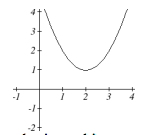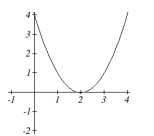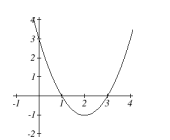Finding Out the Solution Type After the Discriminant
Learning Objectives
- Define the discriminant and use it to classify solutions to quadratic equations
The Discriminant
The quadratic formula not only generates the solutions to a quadratic equation, it tells us about the nature of the solutions. When we consider the discriminant, or the expression under the radical, [latex]{b}^{2}-4ac[/latex], it tells us whether the solutions are real numbers or complex numbers, and how many solutions of each type to expect. The table below relates the value of the discriminant to the solutions of a quadratic equation.
| Value of Discriminant | Results |
|---|---|
| [latex]{b}^{2}-4ac=0[/latex] | One repeated rational solution |
| [latex]{b}^{2}-4ac>0[/latex], perfect square | Two rational solutions |
| [latex]{b}^{2}-4ac>0[/latex], not a perfect square | Two irrational solutions |
| [latex]{b}^{2}-4ac<0[/latex] | Two complex solutions |
A General Note: The Discriminant
For [latex]a{x}^{2}+bx+c=0[/latex], where [latex]a[/latex], [latex]b[/latex], and [latex]c[/latex] are real numbers, the discriminant is the expression under the radical in the quadratic formula: [latex]{b}^{2}-4ac[/latex]. It tells us whether the solutions are real numbers or complex numbers and how many solutions of each type to expect.
Example
Use the discriminant to find the nature of the solutions to the following quadratic equations:
- [latex]{x}^{2}+4x+4=0[/latex]
- [latex]8{x}^{2}+14x+3=0[/latex]
- [latex]3{x}^{2}-5x - 2=0[/latex]
- [latex]3{x}^{2}-10x+15=0[/latex]
We have seen that a quadratic equation may have two real solutions, one real solution, or two complex solutions.
In the Quadratic Formula, the expression underneath the radical symbol determines the number and type of solutions the formula will reveal. This expression, [latex]b^{2}-4ac[/latex], is called the discriminant of the equation [latex]ax^{2}+bx+c=0[/latex].
Let's think about how the discriminant affects the evaluation of [latex] \sqrt{{{b}^{2}}-4ac}[/latex], and how it helps to determine the solution set.
- If [latex]b^{2}-4ac>0[/latex], then the number underneath the radical will be a positive value. You can always find the square root of a positive, so evaluating the Quadratic Formula will result in two real solutions (one by adding the positive square root, and one by subtracting it).
- If [latex]b^{2}-4ac=0[/latex], then you will be taking the square root of [latex]0[/latex], which is [latex]0[/latex]. Since adding and subtracting [latex]0[/latex] both give the same result, the "[latex]\pm[/latex]" portion of the formula doesn't matter. There will be one real repeated solution.
- If [latex]b^{2}-4ac<0[/latex], then the number underneath the radical will be a negative value. Since you cannot find the square root of a negative number using real numbers, there are no real solutions. However, you can use imaginary numbers. You will then have two complex solutions, one by adding the imaginary square root and one by subtracting it.
Example
Use the discriminant to determine how many and what kind of solutions the quadratic equation [latex]x^{2}-4x+10=0[/latex] has.
In the last example, we will draw a correlation between the number and type of solutions to a quadratic equation and the graph of it's corresponding function.
Example
Use the following graphs of quadratic functions to determine how many and what type of solutions the corresponding quadratic equation [latex]f(x)=0[/latex] will have. Determine whether the discriminant will be greater than, less than, or equal to zero for each.
a.

b.

c.

We can summarize our results as follows:
| Discriminant | Number and Type of Solutions | Graph of Quadratic Function |
| [latex]b^{2}-4ac<0[/latex] | two complex solutions | will not cross the x-axis |
| [latex]b^{2}-4ac=0[/latex] | one real repeated solution | will touch x-axis once |
| [latex]b^{2}-4ac>0[/latex] | two real solutions | will cross x-axis twice |
In the following video we show more examples of how to use the discriminant to describe the type of solutions to a quadratic equation.
Summary
The discriminant of the Quadratic Formula is the quantity under the radical, [latex] {{b}^{2}}-4ac[/latex]. It determines the number and the type of solutions that a quadratic equation has. If the discriminant is positive, there are [latex]2[/latex] real solutions. If it is [latex]0[/latex], there is [latex]1[/latex] real repeated solution. If the discriminant is negative, there are [latex]2[/latex] complex solutions (but no real solutions).
The discriminant can also tell us about the behavior of the graph of a quadratic function.
Finding Out the Solution Type After the Discriminant
Source: https://courses.lumenlearning.com/waymakerintermediatealgebra/chapter/read-the-discriminant/